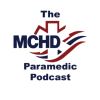Vital signs are called vital for a reason but, in reality, we often view these values with varying degrees of emphasis. When a patient has an oxygen saturation in the 60s or a systolic blood pressure in the 70s, everyone’s alarm bells will sound immediately. What about a heart rate of 130? Sinus tachycardia, unlike hypotension or hypoxia, is more easily ignored or improperly attributed to anxiety, which can lead to disastrous results for our patients.
In this episode of the MCHD Paramedic Podcast, MCHD Medical Director Dr. Casey Patrick takes listeners through a stepwise approach when facing a tachycardic patient. The first task is differentiating between sinus tachycardia and supraventricular tachycardia, which can be quite difficult. Sinus tachycardia can be faster than 150, so beware of that “rule.”
Once sinus tachycardia is confirmed, consider the following diagnoses:
- Infection
- Sepsis
- Bleeding
- Dehydration
- Pulmonary emboli
- Toxidromes
- Drug withdrawal
- Thyroid storm
And no, anxiety is never on this list in the prehospital setting, as suffering from most of the previously mentioned conditions would make anyone anxious. It is vitally important to scan the medication list when caring for a tachycardic patient as anticoagulants and antiplatelets can increase bleeding risks. Drug withdrawal (e.g., benzodiazepines) and drug toxicity (e.g., antihistamines) might only be recognized after noting the medication list as well.
The episode closes with a discussion on the effects of fever on tachycardia and how we can estimate the expected impact of temperature on heart rate. We’ve all been taught that pain increases heart rate, but the evidence says otherwise. It is unwise to chalk a pulse of 130 up to pain from a femur fracture when the patient likely has hemorrhage as the cause of the unstable vital signs. At the conclusion of this episode, you will have a framework and standardized approach to use for any EMS patient that presents with sinus tachycardia.


